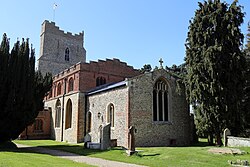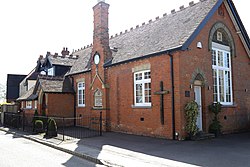High Easter: Difference between revisions
Created page with "{{Infobox town |county=Essex |picture=Church of St Mary, High Easter, Essex, England - from the south-west.jpg |picture caption = Parish church of St Mary |latitude=51.8071 |l..." |
mNo edit summary |
||
| Line 15: | Line 15: | ||
'''High Easter''' is a village and a parish in the Dunmow hundred of [[Essex]]. | '''High Easter''' is a village and a parish in the Dunmow hundred of [[Essex]]. | ||
The village is seven miles north-west of the city of and [[county town]] of [[Chelmsford]]. The parish includes the hamlets of Bishop's Green and Stagden Cross. Parsonage Brook, at 450 | The village is seven miles north-west of the city of and [[county town]] of [[Chelmsford]]. The parish includes the hamlets of Bishop's Green and Stagden Cross. Parsonage Brook, at 450 yards north from the village flows north-east to south-west, meeting at the west of the parish the [[River Can]], whose chief source is at the north, two and a half miles from the village, near Bishop's Green. High Easter is part of 'The Easters', an area adjacent to [[The Rodings]]. The population of the parish at the 2011 Census was 754.<ref>{{cite web|url=http://www.neighbourhood.statistics.gov.uk/dissemination/LeadKeyFigures.do?a=7&b=11124556&c=CM1+4PY&d=16&e=62&g=6426282&i=1001x1003x1032x1004&m=0&r=0&s=1443261392952&enc=1|title=Civil Parish population 2011|accessdate=26 September 2015}}</ref> | ||
==History== | ==History== | ||
Latest revision as of 21:20, 7 February 2018
| High Easter | |
| Essex | |
|---|---|
 Parish church of St Mary | |
| Location | |
| Grid reference: | TL620146 |
| Location: | 51°48’26"N, -0°20’54"E |
| Data | |
| Population: | 754 (2011) |
| Post town: | Chelmsford |
| Postcode: | CM1 |
| Dialling code: | 01279 |
| Local Government | |
| Council: | Uttlesford |
High Easter is a village and a parish in the Dunmow hundred of Essex.
The village is seven miles north-west of the city of and county town of Chelmsford. The parish includes the hamlets of Bishop's Green and Stagden Cross. Parsonage Brook, at 450 yards north from the village flows north-east to south-west, meeting at the west of the parish the River Can, whose chief source is at the north, two and a half miles from the village, near Bishop's Green. High Easter is part of 'The Easters', an area adjacent to The Rodings. The population of the parish at the 2011 Census was 754.[1]
History
The name 'High Easter' refers not to the Christian festival 'Easter', but to the 11th-century Estre (in the Domesday book as Estra), from the Old English eowestre meaning a sheep fold, or 'a place at the sheep fold'. The 'High' part refers to the Old English heah (meaning geographically high), the place name being Heyestre in 1254. The sister village of Good Easter to the south, has the same origin. By 1200 that place was called Godithestre, the 'Good' part of today's place name derived from the Anglo-Saxon woman's name of Godgyth or Godgifu, who probably held possession of the place.[2][3] High Easter developed as a linear settlement to the west of the parish church and was known as 'High Estra' before the Norman Conquest. The 'High' in the name is because of its elevated position, and also to distinguish the village from its neighbour, Good Easter.
Before the Norman Conquest, High Estra belonged to Ely Abbey, but at the time of the Conquest it was seized by Algor, the constable of the army. He was dispossessed by William the Conqueror who gave the manor to Geoffrey de Mandeville. The manor house was today's Grade-II*-listed 'High Easterbury', dating to the 13th century,[4] which is situated to the south-west of the parish church of St Mary. This house and manor was formerly held by the Earls of Essex and the Fitz-Piers, Bohun and Stafford families.
According to Kelly's Directory, the parish land was of clay soil and grew chiefly wheat, beans and barley, and supported a population of 690 in 1891. The lady of the manor was Queen Victoria, with major landowners being Lord Rayleigh, Sir Brydges Powell Henniker 4th Henniker baronet, and the trustees of the late Lord Dacre. The Church of St Mary had been "thoroughly restored in 1865 at a cost of £2,200". The church incumbency, vicarage, residence and glebe, was in the gift of the Bishop of London. High Easter's vicar since 1849 was the Rev. Edward Francis Gepp M.A. of Wadham College, Oxford, who was also rural dean of Roding and a JP for Essex. Attached to St Mary's was a National School for 201 mixed children with an average attendance of 60.[5]

A further village school was Manning Prentice Memorial School for 100 mixed children, with an average attendance of 73; this school, erected in 1893, was attached to the Congregational chapel which had seating for 300. Parish occupations in 1895 included a tailor & draper, a blacksmith, two wheelwrights, one of whom was also a carrier, two grocers, one of whom was also a draper and an agent for W. A. Gilbey wine and spirit merchants, a saddler & harness maker, a beer retailer, a shoe maker, a miller using wind and steam, eight farmers, two of whom were landowners and one a carrier, two licensed victuallers of public houses, and two farm bailiffs.[5]
Quoting the archeologist Miller Christy, J. Charles Cox wrote in his 1909 guide book Essex (The Little Guides): "In and around the Easters are many old farmhouses of timber and plaster, formerly residences of greater consequence than at present; many are moated and have large or ornamented brick chimneys".[6]
Community
High Easter village has a post office and cafe, a parish church, restaurant, village hall, football pitch and cricket pitch. Within High Easter parish are 70 listed buildings and structures: houses, farmhouses, cottages, barns and pubs, and also a post office, a brew house, and a gatehouse.[7]
St Mary's Parish Church on The Street in High Easter village is Grade-I listed and dates in part to the to the 12th century.[8][6]
References
- ↑ "Civil Parish population 2011". http://www.neighbourhood.statistics.gov.uk/dissemination/LeadKeyFigures.do?a=7&b=11124556&c=CM1+4PY&d=16&e=62&g=6426282&i=1001x1003x1032x1004&m=0&r=0&s=1443261392952&enc=1. Retrieved 26 September 2015.
- ↑ Mills, Anthony David (2003); A Dictionary of British Place Names, Oxford University Press, revised edition (2011), p. 168. ISBN 019960908X
- ↑ "Place-name Meanings in Uttlesford", Recording Uttlesford History. Retrieved 29 January 2018
- ↑ National Heritage List 1147300: High Easterbury
- ↑ 5.0 5.1 Kelly's Directory of Essex 1895
- ↑ 6.0 6.1 Cox, J. Charles (1909). Essex. Methuen & Co. Ltd.. p. 100.
- ↑ "Listed Buildings in High Easter, Uttlesford, Essex", British Listed Buildings. Retrieved 30 January 2018
- ↑ National Heritage List 121378: Parish Church of St Mary
Outside links
| ("Wikimedia Commons" has material about High Easter) |
- "Miller Christy (1861-1928)", Goldhanger-past website. Retrieved 30 January 2018
